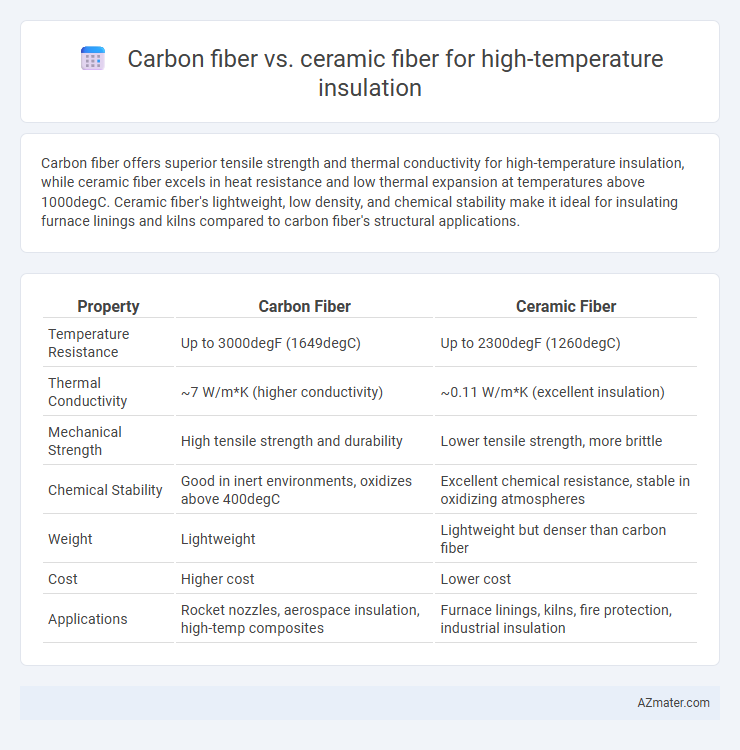Carbon fiber offers superior tensile strength and thermal conductivity for high-temperature insulation, while ceramic fiber excels in heat resistance and low thermal expansion at temperatures above 1000degC. Ceramic fiber's lightweight, low density, and chemical stability make it ideal for insulating furnace linings and kilns compared to carbon fiber's structural applications.
Table of Comparison
| Property | Carbon Fiber | Ceramic Fiber |
|---|---|---|
| Temperature Resistance | Up to 3000degF (1649degC) | Up to 2300degF (1260degC) |
| Thermal Conductivity | ~7 W/m*K (higher conductivity) | ~0.11 W/m*K (excellent insulation) |
| Mechanical Strength | High tensile strength and durability | Lower tensile strength, more brittle |
| Chemical Stability | Good in inert environments, oxidizes above 400degC | Excellent chemical resistance, stable in oxidizing atmospheres |
| Weight | Lightweight | Lightweight but denser than carbon fiber |
| Cost | Higher cost | Lower cost |
| Applications | Rocket nozzles, aerospace insulation, high-temp composites | Furnace linings, kilns, fire protection, industrial insulation |
Introduction to High-Temperature Insulation Materials
Carbon fiber offers exceptional strength-to-weight ratio and thermal stability, making it ideal for high-temperature insulation applications in aerospace and automotive industries. Ceramic fiber excels in resisting extreme heat and thermal shock with superior insulating properties up to 1800degC, commonly used in furnaces and kilns. Both materials provide critical solutions for energy efficiency and safety in environments exposed to intense heat.
Overview of Carbon Fiber Insulation
Carbon fiber insulation offers exceptional thermal stability, withstanding temperatures up to 3,000degF (1,650degC) while maintaining structural integrity and low thermal conductivity. Its lightweight and high tensile strength make it ideal for aerospace, automotive, and industrial applications requiring efficient heat resistance and durability. Compared to ceramic fiber, carbon fiber provides superior mechanical performance but may require protective coatings to prevent oxidation at extremely high temperatures.
Overview of Ceramic Fiber Insulation
Ceramic fiber insulation offers excellent thermal resistance withstanding temperatures up to 2300degF (1260degC), making it ideal for high-temperature applications such as furnaces, kilns, and petrochemical industries. Its low thermal conductivity and lightweight nature provide superior energy efficiency and ease of installation compared to traditional insulation materials. Ceramic fibers also exhibit outstanding chemical stability and corrosion resistance, ensuring long-term durability in harsh environments.
Thermal Performance Comparison
Carbon fiber offers superior thermal conductivity and higher strength retention at elevated temperatures up to 600degC, making it ideal for applications requiring both insulation and structural support. Ceramic fiber withstands much higher temperatures, often exceeding 1260degC, with lower thermal conductivity enabling excellent insulation but reduced mechanical strength. Thermal performance comparisons highlight carbon fiber's efficiency in heat dissipation and durability, while ceramic fiber excels in extreme temperature resistance and insulating capability.
Mechanical Strength and Durability
Carbon fiber exhibits superior mechanical strength and durability at elevated temperatures compared to ceramic fiber, maintaining structural integrity under thermal cycling and mechanical stress. Ceramic fiber provides excellent thermal insulation but tends to be more brittle and prone to cracking when exposed to mechanical strain or impact. The high tensile strength and flexibility of carbon fiber make it the preferred choice for applications requiring both high-temperature resistance and mechanical resilience.
Chemical Resistance and Stability
Carbon fiber exhibits superior chemical resistance and stability at high temperatures, maintaining structural integrity in oxidative and corrosive environments up to approximately 600degC. Ceramic fiber outperforms carbon fiber in thermal stability, remaining stable beyond 1000degC while resisting a wide range of chemical agents, including alkalis and acids, making it ideal for extreme industrial applications. However, ceramic fiber's brittleness contrasts with carbon fiber's higher mechanical resilience, influencing material selection based on specific insulation performance and durability requirements.
Weight and Density Differences
Carbon fiber offers significantly lower density, typically around 1.6 g/cm3, resulting in lighter insulation materials compared to ceramic fiber, which has a density ranging from 2.4 to 3.0 g/cm3. This weight advantage makes carbon fiber insulation ideal for aerospace and automotive applications where minimizing mass is critical. The lower density of carbon fiber also contributes to enhanced thermal insulation performance by reducing conductive heat transfer in high-temperature environments.
Ease of Installation and Handling
Carbon fiber insulation offers superior ease of installation due to its lightweight and flexible properties, allowing for quick cutting and shaping with minimal tools. Ceramic fiber, while excellent for high-temperature resistance, tends to be more brittle and dusty, necessitating protective gear and careful handling to prevent fiber breakage and irritation. The choice between carbon fiber and ceramic fiber for insulation depends largely on the installation environment and the priority given to ease of handling versus thermal performance.
Cost Analysis and Affordability
Carbon fiber insulation typically exhibits higher initial costs compared to ceramic fiber due to its advanced material properties and manufacturing complexity. Ceramic fiber offers a more affordable solution for high-temperature insulation, delivering effective thermal resistance at lower price points, making it suitable for budget-conscious industrial applications. While carbon fiber provides superior durability and thermal performance, ceramic fiber remains the cost-effective choice for most high-temperature insulation needs.
Applications and Industry Use Cases
Carbon fiber excels in high-temperature insulation applications requiring lightweight strength and thermal resistance, making it ideal for aerospace components, automotive exhaust systems, and industrial furnace linings. Ceramic fiber offers superior thermal stability and chemical resistance, widely used in kilns, power plants, and metal processing industries for refractory linings and insulation blankets. Both materials serve distinct industrial needs, with carbon fiber favored for structural durability and ceramic fiber for extreme heat environments.

Infographic: Carbon fiber vs Ceramic fiber for High-temperature insulation
 azmater.com
azmater.com